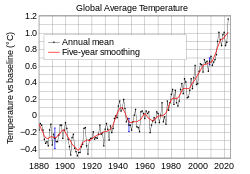- Thread starter
- #41
This is a compelling look at the role of solar activity in global warming. Others have noted the connection between sunspots and warming without explaining any possible mechanism to explain it. This video does offer that connection.
While I still think that positive feedbacks are going to do a number on our climate, this is the best alternative view of why current models are not as accurate as they should be.
That is a pretty long video. Would you be willing to summarise? What are the basics? If necessary, I will do further research based on that. I know this is a complex issue, and is likely not explained in a short format, however, If you could try to, or at least direct me to where I might find such a summary, I would certainly appreciate it.
It's really about half as long as it appears because there's a lengthy Q and A of dubious value at the end but here's the gist of it:
There's a strong correlation between sunspot activity and global temperature increase. I used to think this was a correlation without causation because if an aspect of solar activity were to have an effect, it would be solar output. Solar output probably does have an effect but the variation is extremely small so it doesn't do much. Why does sunspot activity matter? It's because strong gusts of solar wind affect the earth's magnetosphere and vary the amount of cosmic radiation that gets through. This cosmic radiation causes cloud cover to be more or less reflective and thus allows the solar radiation to warm or cool the planet.
Thank you, I have seen/heard this argument before. I have even made the case myself. Of course whenever I do, I am called a "science denier". I wonder what the fallout will be from this guy's lecture....
Hopefully, they'll incorporate it into the models that they have. Even though this is a significant contributor, you can see from the overlay upon actual (and modeled) global temperature that there are a lot of other very significant contributors from the environmental processes that are being measured and increasingly understood. The doctor who made this presentation says that sunspot activity is unpredictable but has bounds of both magnitude and duration so while no really accurate prediction can be made, a range of predictions could be. He believes that the typical cycles of the sun would most likely give us an additional 1 degree C increase but I don't think he's including positive feedbacks so we're not done yet.
To be honest the models they have are worse than useless. The first problem they have is they are simple. A simple model is not capable of modelling the real world. It just isn't, and can never be. What i would like to see is some real effort to build a computer model that actually can work. As an example Formula One racing teams use Computational Fluid Dynamics computer models that cost millions of dollars, and are run by dozens of people to look at the aerodynamic impact of minor changes to the various bits of the chassis. That is all they do.
Climatology on the other hand has wasted tens of billions of dollars on "studies" that use simple models that are so bad that no matter what number you plug into them they always generate a warming trend. Furthermore they can't even do a one day hindcast with absolutely perfect knowledge of all of the variables involved. Until they can at least come close to doing that the models are less than worthless.
The models the use are not simple. The simulate the wind and ocean currents that Formula One and aviation companies use and incorporate many more processes in addition.

